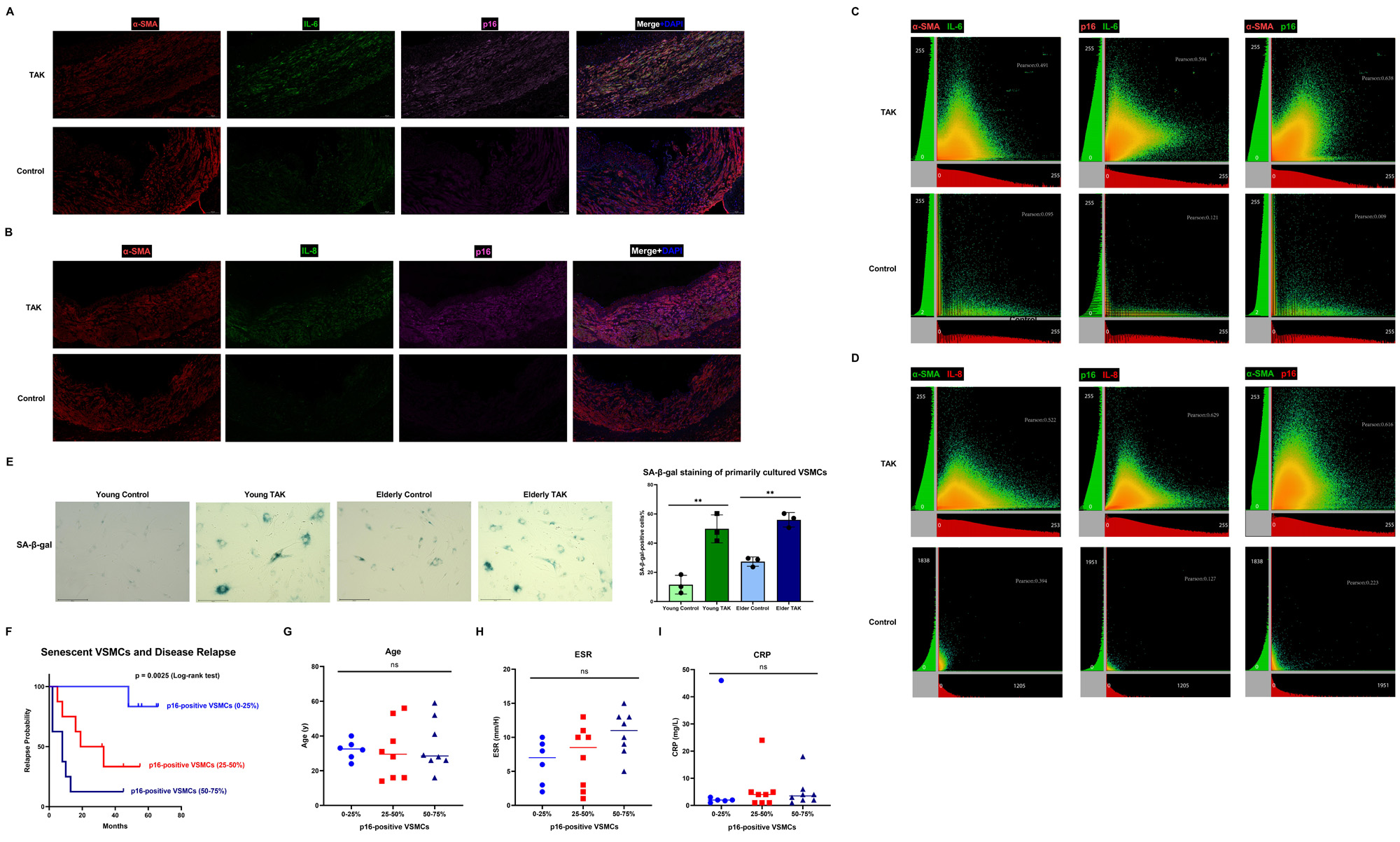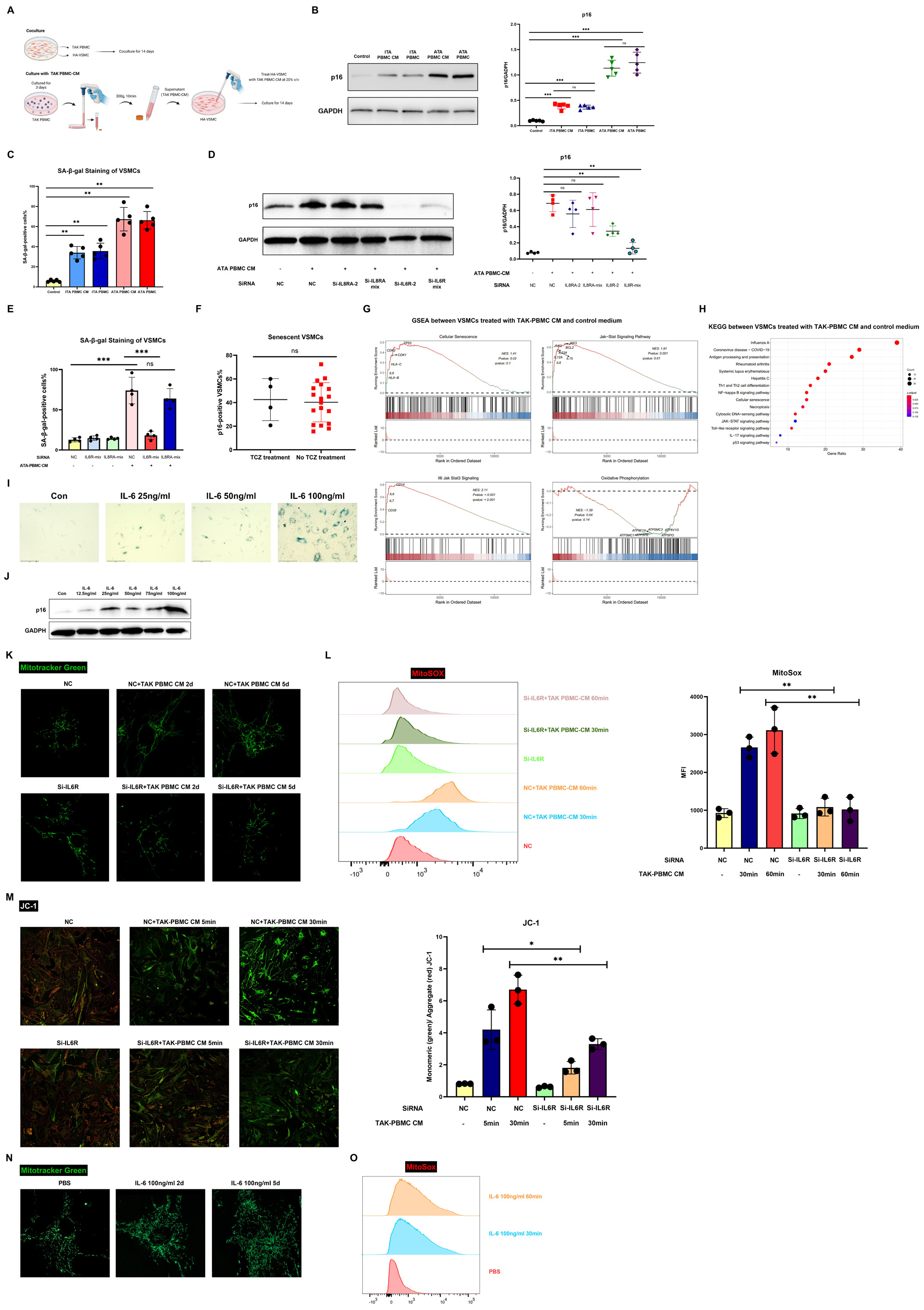Session Information
Date: Wednesday, November 15, 2023
Title: Abstracts: Vasculitis – Non-ANCA-Associated & Related Disorders III: Innovation
Session Type: Abstract Session
Session Time: 11:00AM-12:30PM
Background/Purpose: Takayasu’s arteritis (TAK) is characterized by persistent vascular inflammation involving aorta and its main branches, which is an important prosenescent factor that in turn amplifies local inflammation via senescence-associated secretory phenotype (SASP). In this study, we aimed to explore the pathogenic role of vascular smooth muscle cells (VSMCs) senescence and the relevant prosenescent pathway in TAK.
Methods: Cellular senescence markers were tested in vascular samples from patients with TAK using immunofluorescence, western blot and SA-β-gal staining. The key prosenescent inflammatory cytokine and its downstream intracellular events were investigated in a series of in-vitro and ex-vivo experiments including coculture experiments, RNA-Seq, gene knockdown, mitochondrial assays, co-immunoprecipitation, and tissue culture.
Results: The features of premature VSMCs senescence, including upregulated p16 expression, more intense SA-β-gal staining, and SASP consisting of increased interleukin-6 (IL-6) and IL-8 expression, were detected in TAK patients, compared with age- and sex-matched control subjects (Figure 1). Treatment with conditioned medium of peripheral blood mononuclear cell (PBMC) from patients (TAK-PBMC CM) and coculture with TAK-PBMC exerted similar prosenescent effects on VSMCs via IL-6 signaling. RNA-Seq suggested that cellular senescence and IL-6-STAT3 pathway were upregulated, while oxidative phosphorylation pathway was downregulated in TAK-PBMC CM-treated VSMCs. TAK-PBMC CM treatment induced multiple senescence-associated mitochondrial dysfunctions that can be significantly improved by IL-6 receptor knockdown (Figure 2). IL-6-induced noncanonical mitochondrial localization of phosphorylated STAT3 (Tyr705) prevented mitofusin 2 (MFN2) from proteasomal degradation, and subsequently promoted mitochondrial elongation and cellular senescence in VSMCs. In addition, coculture with MFN2 activator MASM7-induced senescent VSMCs led to an immunosenescence-like and cytotoxic phenotype switch in TAK-PBMC that can be detected in treatment-naïve patients, including decreased frequencies of naïve T cells, increased frequencies of TEMRA cells, age-associated B cells and CD16brightCD56dim NK cells, and upregulated NKG2D expression in CD4+ T cells (Figure 3). Of clinical relevance, although no significant difference of ESR and CRP levels was observed among patients with various senescent VSMCs proportions, patients with higher percentage of senescent VSMCs were more likely to relapse (Figure 1). However, senescent VSMCs proportions in vascular samples were comparable between patients taking long-term tocilizumab treatment ( >1 year) and those receiving other therapies, which is contradicting our expectation. Instead, treatment with mitoCur-1 (mitochondrial STAT3 inhibitor) or MFI8 ameliorated (MFN2 inhibitor) VSMCs senescence in ex vivo cultured arteries of patients with TAK (Figure 3).
Conclusion: VSMCs of patients with TAK exhibited the features of cellular senescence. IL-6-mitochondrial STAT3-MFN2 signaling is an important driver of VSMCs senescence. This may provide new insights into the mechanisms governing inflammation in TAK.
To cite this abstract in AMA style:
Fang C, Du L, Li L, Chen Y, Chen Z, Li Y, Li J, Li M, Zeng x, Tian X. Premature Vascular Smooth Muscle Cells Senescence Driven by Interleukin-6-Mitochondrial STAT3-Mitofusin 2 Signaling in Takayasu’s Arteritis [abstract]. Arthritis Rheumatol. 2023; 75 (suppl 9). https://acrabstracts.org/abstract/premature-vascular-smooth-muscle-cells-senescence-driven-by-interleukin-6-mitochondrial-stat3-mitofusin-2-signaling-in-takayasus-arteritis/. Accessed .« Back to ACR Convergence 2023
ACR Meeting Abstracts - https://acrabstracts.org/abstract/premature-vascular-smooth-muscle-cells-senescence-driven-by-interleukin-6-mitochondrial-stat3-mitofusin-2-signaling-in-takayasus-arteritis/



